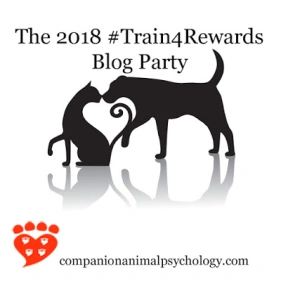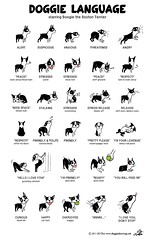Posts tagged ‘#dogtraining’
Behavior Shaping Game (for Humans)
[long nerdy post warning]

I am very lucky to have inspiring professional dog trainers in my life who help me be a better dog geek and parent. When my dog trainer friend Sarah Owings asked if I wanted to playtest a “Tabletop Shaping Game” as her lab rat, my answer was YES YES YES.
Sarah’s game is a version of a behavior shaping game (for humans) developed many years ago by renowned UK dog trainer Kay Laurence, to help dog trainers become better trainers. When our dogs fail to learn something, make mistakes, or get frustrated, this is usually because something in the training plan isn’t working. The games are for trainers to hone their skills in testing, refining, and fixing their training plans. The learner or the dog is never blamed or punished.
There is also a variant of this game called PORTL (portable operant research teaching laboratory) that is used by the University of North Texas for research into Behavior.
In Sarah’s version of the game:
- There is 1 Teacher and 1 Learner
- The game is played with objects on a table, a clicker, and reinforcers. (reinforcers/”treats” are represented by small objects – there are a few different kinds) The Learner chooses their reinforcer before the start of the game.
- Each mini-session is short – 10 reinforcers per session. We work on ONE goal at a time.
- Click + reinforcer = Learner is to repeat the behavior. No click = try something else.
- There is no talking while the Learner is working.
- Each player takes notes at the end of each session and there is discussion at the end of the game. Was the Learner Happy? Confused? Thoughtful? Frustrated?
My partner Nathan, and I both took turns being the Teacher and the Learner. In between the sessions, Sarah privately instructed the Teacher what to do. I can’t go into all the details of the game we played because this would be like publishing spoilers and ruining it for everyone, but I will share general insights from MY experience.
It was interesting to FEEL what it’s like being the “dog” and learning about how Nathan and I learn differently!
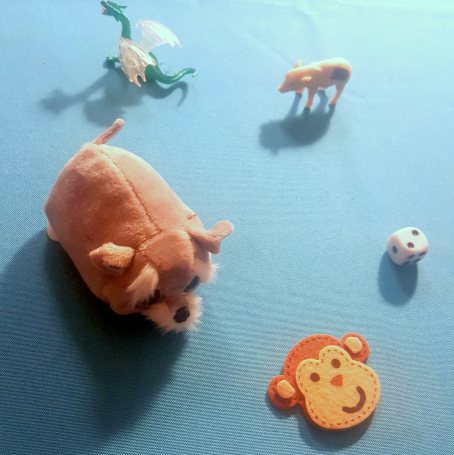
GAME 1: Nathan trains me to Flip His Monkey (not a euphemism).
The goal was to allow me to explore the objects on the table and then Nathan was to strengthen ONE behavior with added reinforcement (Click & R+).
Sarah gave an example: “the way a dog might initiate jumping up behavior at the door, then get reinforced for it by humans looking down, talking to him, pushing him down, and doing other exciting things in response.“
I personally don’t have any issue with Boogie jumping up, but here’s a reinforced behavior I know too well.
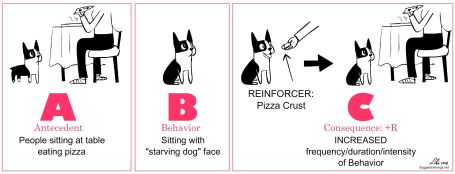
When I touched the monkey head on the table, he CLICKED and gave me a “treat”. None of the other objects on the table earned me a click. I learned quickly that the target behavior had to do with the Monkey. Every time I touched the Monkey, I received a Click and R+ so I kept touching the Monkey.

Observations:
- One time Nathan clicked when I did something different (put the Monkey on the Frog), so I repeated the different behavior, and when I didn’t receive a click, I was momentarily confused. Later, I read his notes and he had written “I screwed up” – he had accidentally clicked a behavior he didn’t mean to click. It wasn’t a big deal because I was being clicked many times afterwards for doing the correct behavior.
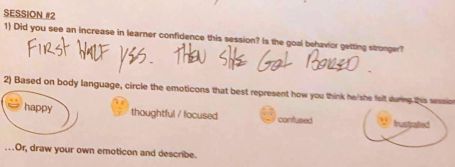
- At the end of the game, when Nathan and I compared notes, I had circled “Happy” and “Thoughtful/Focused” on my sheet of paper, but according to Nathan, I seemed frustrated like I wanted MORE. “You wanted to build something with ALL the objects on the table”. This was true – after being clicked 30 times for repeatedly picking up and flipping the Monkey, I was bored and had started interacting with the other objects on the table to see if there was something else that could earn me clicks.
- In the 3rd session, the other objects had been removed from the table so it was clear that I had to interact only with the Monkey.
Sarah: “We learned that you are a learner that enjoys novelty, puzzles, more interesting challenges–those types of actions are more reinforcing for you than simply getting the right answer. This is what I love best about training. Ever when the teacher’s plans go awry, if you listen to what your learner is telling you, you learn how to teach that learner better in the future.”
GAME 2: Lili trains Nathan to Put His Finger in my Scrunchie (also not a euphemism)

There was a Scrunchie on the table – no other objects present – and the goal was to have Nathan put his finger in the Scrunchie- and he took to it so quickly – only after 2 clicks, that Sarah instructed me to put this behavior on cue in the next session.
My cue was a card with a yellow diamond on it.
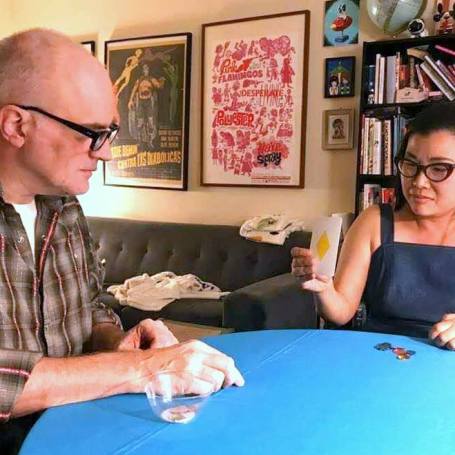
Sarah: “The order here is very important…First you hold up the cue card…THEN you moved the scrunchie in front of him…behavior…Click R+. Not the other way around”
When Nathan got it right very quickly, my next goal was to teach Stimulus Control. ie, Nathan should put his finger in the scrunchie when I give the cue. When I don’t give the cue, he shouldn’t put his finger in the scrunchie.
Here was something new to me – first of all, I had to establish a Off-Cue Behavior (in this case, eye contact from Nathan) that I could also click and treat. The goal with having Off-Cue and On-Cue Behaviors is to to reduce learner errors and/or frustration and keep the rate of reinforcement up. The Learner will always get reinforced for something, and no punishment or extinction is necessary.
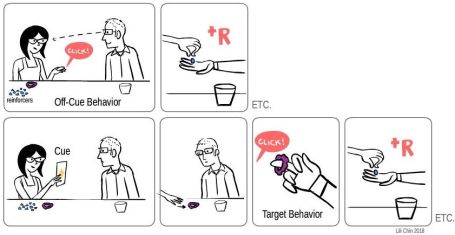
In contrast, an illustration of what Negative Punishment (= removing something to prevent behavior from recurring) would look like, which can make the Learner shut down or hesitate to keep playing, or feel frustrated if they didn’t get the Cue to begin with.

Observations:
- When I first held up the cue card, Nathan stopped. He stared at the card for a long time before picking up the scrunchie. Later, he told us he saw the yellow card as “a penalty card” like in soccer, so he had immediately interpreted this as a NO signal. This was a great example of Learners bringing past experiences to the table.
Sarah said – Imagine teaching a dog a new cue for SIT which is a hand signal (she lowered her hand with palm faced down), and what if in a previous home this is the same hand signal the dog would see before every time he got hit.
The cue that we think is neutral, may not be neutral for this individual dog. It may have other negative associations of which we are not aware. It’s important to pay attention/listen to our individual Learner so we can choose our cues with care, and train accordingly.
- When I was training the Off-Cue Behavior, (no cue card) I started with no scrunchie on the table, and added this back later. The very first time that I added the scrunchie back in front of Nathan with no cue, he stared at it for a long while. He then picked up the scrunchie and put his finger in it, and when I didn’t click, he put it back down and looked at me like he knew he shouldn’t have done that. This was actually MY mistake. I changed the criteria, added the distraction, and should have clicked when he first got it right, instead of waiting for a different behavior.
Sarah: “Clicking just for holding still for half a second, with hands in lap, would have ensured that he NOT interact with it on the first round and cemented the information that sitting still was correct. Instead, you waited a long time, waiting for eye contact. Eventually he was not sure about what you wanted and made a mistake–putting the scrunchie on his finger off-cue. But Nathan’s one error was informative for him. He interacted with the scrunchie–no click. He put it down and looked at you. You presented the cue–back on track. You made good teaching choices there.”
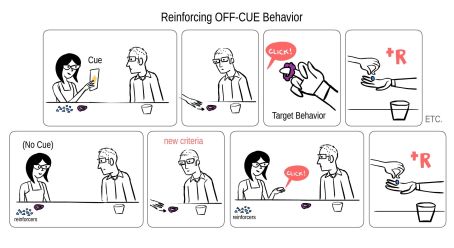
In 40 repetitions, Nathan made a (off-cue behavior) mistake only ONCE. That was pretty good, I thought. 🙂
Also for some reason, whenever Nathan gave me eye-contact he would burst into laughter which then made me laugh. The more I clicked this eye-contact, the session turned into a laugh-fest. We could both circle “Happy” on our review sheets.
To summarize, these Behavior Shaping Games were a fun and fascinating way to experience how operant conditioning works, the power of clear non-verbal communication, and individual learning styles.
Most importantly, I got a sense of what it might feel like to be a dog being trained by a human-trainer, (Sorry, Boogie. I have so much more empathy for you, now!) and a much clearer sense that there are two individuals involved in this training game.
I think Nathan was a better Learner – he was way more focused with his attention. I was more all over the place as a Learner and got bored even without realizing I got bored until this was pointed out to me later.
To those “Obedience” people who dismiss Positive Reinforcement training as something like “bribery” or “spoiling the dog” – this couldn’t be further from the truth. When done well, I see R+ training is an admirable skill and demonstrates good planning, good timing, an ability to read your learner and change your training plan to help them succeed and not be frustrated. There is so much brain and heart in this approach to training.
Thank you, Sarah!
P.S. Boogie is deaf in his old age, so I no longer use the clicker or any verbal cues. I use a “thumbs up” for a click/yes.
RELATED:
Check out this amazing video by expert trainer Mary Hunter. It’s super advanced but offers a great example of training/shaping without using words, planned in such a way that the learner gets it right 100% of the time. (This blog post by Mary Hunter is also worth reading: When Teaching Doesn’t Equal Learning)
